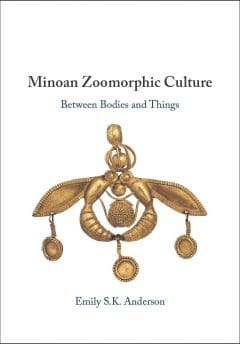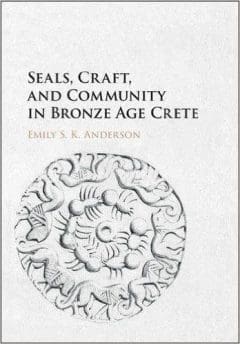
Emily S. K. Anderson
Associate Professor of Classics; Director of Undergraduate Studies; Director, Johns Hopkins Archaeological Museum
Contact Information
- [email protected]
- Curriculum Vitae
- Gilman 190
- 410-516-7556
Research Interests: Aegean and Eastern Mediterranean Bronze Age art and archaeology, material culture, craft, glyptic, human/non-human relations, the ongoing biographies of ancient forms and materials
Education: PhD, Yale University
Emily Anderson’s research and fieldwork primarily concern the material and visual cultures of the Aegean and eastern Mediterranean Bronze Age with a focus on the ways in which objects are involved in the relations, negotiations and unfolding of sociocultural life. Particular studies examine corpora of material that range in context from Early Minoan Crete to the Mycenaean sphere of interaction during the Late Bronze Age. She received her PhD in Archaeology from Yale University (2009), preceded by an MPhil from Yale and a BA with honors in Old World Archaeology and Art from Brown University.
Dr. Anderson’s first book, Seals, Craft and Community in Bronze Age Crete (Cambridge University Press, 2016), examines a group of stamp seals from the transitional Early-to-Middle Minoan period on Crete that are both engraved with the island’s earliest glyptic iconography and fashioned of imported hippopotamus ivory. The book investigates the implications of these novel aspects of the objects, considering how the imagery engraved on the seals developed practically and symbolically, and how that relates to their prominent use of a rare imported raw material. By embedding these extraordinary objects within the broader context of the time, Dr. Anderson further examines how the seals are but one element of a process of social and spatial “incorporation” on the island, as the nature and scale of persons’ relations to one another were fundamentally reformulated. This study consequently considers various dimensions of social experience and action, from fine-scale handwork of semi-itinerant craftspersons to performative displays at public gatherings, from the forging of footpaths linking distant communities to the development of shared symbolic forms.
Anderson’s second book, Minoan Zoomorphic Culture: Between Bodies and Things (2024, Cambridge University Press), concerns the complex engagement of humans and non-humans in Bronze Age Crete and the Aegean. This project focuses on how representational objects can be understood as vibrant animal bodies, animated by their own distinctive dynamisms. The unique physical, material and mechanical qualities of these things contribute to peculiar affordances in their relations with people and environments. The inter-corporealities of human bodies and these object bodies have potentially powerful sensorial, emotional and social dimensions, and constitute vital creative aspects of people’s embodied relations with non-humans.
Anderson’s current book project, Syncopated Ancient: The Early Mediterranean ReCreated in the Fiber of a Modern American City, investigates the particular practices and material culture through which residents of late-19th to mid-20th century Baltimore accessed, considered and reimagined the ancient past, and how the realities of those engagements substantively gave new and lasting form to ancient cultures themselves. This examination fundamentally reconsiders the status and impact of objects and renderings that have often been deemed secondary or even inauthentic, including reproductions, replicas, counterfeit artifacts, performance backdrops and costumes, and hybridizing reworkings. With a re-focus on a wide spectrum of objects and venues in the Baltimore region, a diversity of persons from different communities and walks of life come to the fore as key contributors. Two corpora of objects constitute jumping-off points for this study: a collection of plaster casts of “classical” sculpture commissioned ca. 1879, and a group of reproductions of Minoan and Mycenaean objects crafted in the early 20th century. These two groups of things differ in their substance, contexts, color and associations. They help us to consider the people and social relations that supported, surrounded and engaged such material, and the real creative work that brought new presence to the ancient past in the American city.
Dr. Anderson’s research and fieldwork in the Aegean extend back over two decades, and have focused on artifact studies, archaeological excavation, survey, and illustration. These projects have ranged in locale from Crete to the Greek mainland, covering periods from the Final Neolithic to the early Classical and centering primarily on the Early–Late Bronze Age. She has been part of multiple large-scale field projects, including the Eastern Korinthia Archaeological Survey, the Azoria Excavations, the Saronic Harbors Archaeological Research Project, and the Eastern Boeotia Archaeological Project. Presently she is planning a significant field and research project with the Corinthian Ephorate of Antiquities (Greece), with collaborative efforts focused on developing nested, multi-scalar biographies of an archaeological site, in its sociocultural, interactive and environmental dimensions.
Dr. Anderson’s teaching at Hopkins spans the societies and cultures of the early Aegean and eastern Mediterranean, as well as the theoretical/interpretive topics through which we seek to gain insights into past human experience. In recent years she has taught courses such as: Craft and Craftspersons of the Ancient World; Gender and Sexuality in Early Greece and the Eastern Mediterranean; Past is Present: Cultural Heritage and Global Politics; The Art and Archaeology of Early Greece; Making Identities: How Archaeology Constructs People in the Past and Present; and Archaeology at the Crossroads: the Ancient Eastern Mediterranean through Objects in the JHU Archaeology Museum. She frequently incorporates the Johns Hopkins Archaeology Museum and other area museums into her teaching and believes strongly that giving students the opportunity to engage directly with ancient material culture fundamentally alters the ways they approach and question past cultures.

Minoan Zoomorphic Culture: Between Bodies and Things
- author
- Cambridge University Press , 2024

Seals, Craft, and Community in Bronze Age Crete
- author
- Cambridge University Press , 2016
- “The Reinvented Social Somatics of Ritual Performance on Early Crete: Engagements of Humans with Zoomorphic Vessels” In K. Morgan ed., Pomp, Circumstance, and the Performance of Politics: Acting Politically Correct in the Ancient World. Oriental Institute Seminars. Chicago: Oriental Institute of the University of Chicago; 2024: 99-129.
- “Intuitive Things: Helmets, Shields, Ikria and the Uniqueness of Aegean Composites” In T. Palaima and R. Laffineur, eds., ZOIA: Animal Connections in the Aegean Middle and Late Bronze Age. Leuven: Peeters, 2021: 149-160.
- “The Poetics of the Cretan Lion: Glyptic and Oral Culture in the Bronze Age Aegean” American Journal of Archaeology 124 (3); July 2020: 345-379.
- “A Sense of Stone and Clay: The Inter-Corporeal Disposition of Minoan Glyptic” In M. Cifarelli ed., Fashioned Selves: Dress and Identity in Antiquity. Oxford: Oxbow; 2019: 203-218.
- “Connecting with Selves and Others: Varieties of Community-Making across Late Prepalatial Crete” In S. Cappel, U. Günkel-Maschek, and D. Panagiotopoulos eds., Minoan Archaeology, Challenges and Perspectives for the 21st Century. Louvain: Aegis, Presses universitaires de Louvain; 2015: 199–211.
- “Re-Embodying Identity: Seals and Seal Impressions as Agents of Social Change on Late Prepalatial Crete” In J. Englehardt ed., The Archaeology of Agency in Ancient Writing. Boulder: University Press of Colorado; 2013: 115-138.
- “Signs in Human Hands: A Model for the Intonated Object” In Y. Rowan ed., Beyond Belief: The Archaeology of Religion and Ritual. Archaeological Papers of the American Anthropological Association, 19. University of California Press; 2012: 166-179.
- “Through Vessels of Embodied Action: Approaching Ritual Experience and Cultural Interaction through Late Mycenaean Rhyta” In G. W. M. Harrison and J. Francis eds., Life and Death in Ancient Egypt: The Diniacopoulos Collection. Montréal: Concordia University; 2011: 73-88.
- “Difference on a Common Ground: The Parading Lions Seal Group and Collective Action on Late Prepalatial Crete” In Morton and D. Butler eds., It’s Good To Be King: The Archaeology of Power and Authority. Proceedings of the 41st Annual Chacmool Archaeological Conference, University of Calgary, Alberta, Canada. Calgary: University of Calgary; 2011: 199-212.